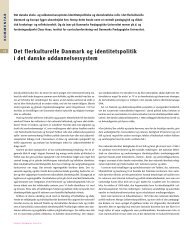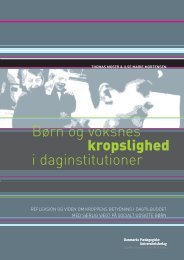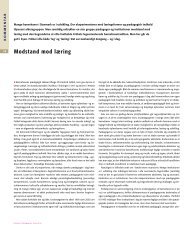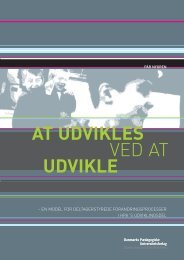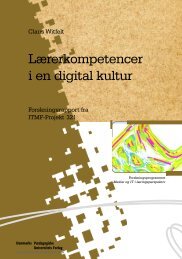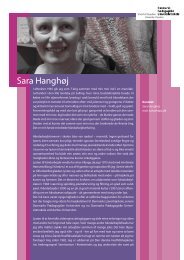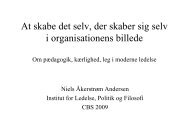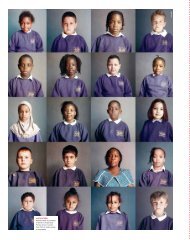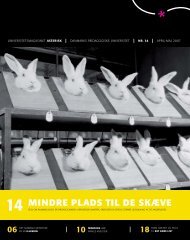SRI-Teknisk rapport-sen.v13 - DPU
SRI-Teknisk rapport-sen.v13 - DPU
SRI-Teknisk rapport-sen.v13 - DPU
Create successful ePaper yourself
Turn your PDF publications into a flip-book with our unique Google optimized e-Paper software.
1995 518.1 22.8 506.1 20.1 512.4 17.1 519.0 21.4<br />
512.8 17.0<br />
1996 518.7 22.9 511.3 20.0 513.0 17.6 518.3 23.8<br />
511.5 19.0<br />
1997 521.8 24.1 513.9 22.5 517.1 17.5 518.9 24.9<br />
514.4 20.0<br />
1998 523.6 22.9 518.7 19.4<br />
Note. The sample sizes (number of schools across<br />
grades) for the subject areas were as follows: Math<br />
(86), Writing (86), Reading (86), Science (116), and<br />
Social Studies (111). MSPAP = Maryland State Performance<br />
Assessment Program; Adm. = administration<br />
year.<br />
In 1993, schools in the lower quartile (which reflects<br />
higher SES) were concentrated in the range<br />
of<br />
520 to 550, whereas schools in the upper quartile<br />
(which reflects lower SES) were<br />
concentrated in the range of 480 to 500. In addition,<br />
the rate of change for schools<br />
in the lower quartile exhibited a more consistent<br />
increase with time, whereas considerably<br />
more variability was observed for schools in the<br />
upper quartile. In both<br />
cases, the rate of change appears modest from 1993<br />
to 1998, a finding that is consistent<br />
with results for other assessment programs.<br />
The finding that students’ perceptions of the degree<br />
to which they worked on<br />
MSPAP-like tasks was negatively related to 1998<br />
MSPAP performance is interesting,<br />
and in the case of MSPAP science performance,<br />
there is an apparent paradox<br />
between the direction of the relationship for Current<br />
Instruction (b = 5.9) and<br />
students’ perception of MSPAP-like Instruction (b =<br />
–4.0). As teachers’ instruction<br />
more closely reflected the Maryland Learning<br />
Outcomes and reform-oriented<br />
problem types, higher 1998 MSPAP performance was<br />
observed. In contrast, student<br />
perception of the degree to which they worked on<br />
MSPAP-like tasks was<br />
negatively related to 1998 MSPAP performance.<br />
Several possible explanations<br />
exist for this finding. For example, students were<br />
administered the student questionnaire<br />
just after the MSPAP, and other studies indicated<br />
that MSPAP test preparation<br />
activities were more aligned with the MSPAP than<br />
instructional activities<br />
were (e.g., Cerrillo, Han<strong>sen</strong>, Parke, Lane, & Scott,<br />
105



